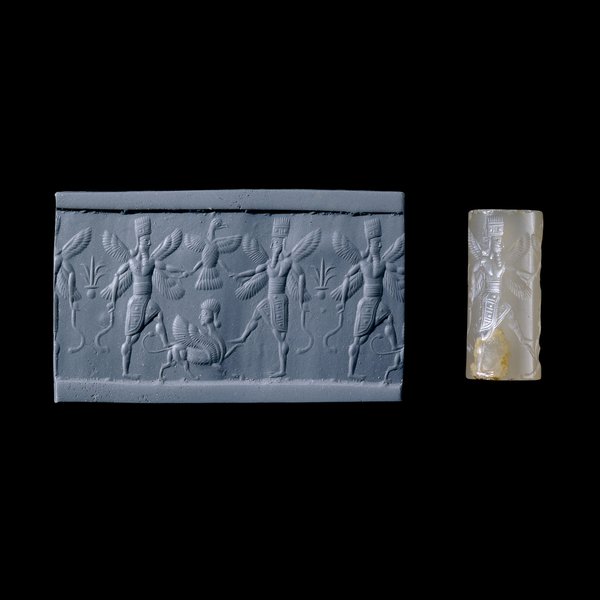الختم العقيق الأسطواني
Chalcedony cylinder seal
ختم العقيق الأسطواني
النيو سلالة بابل، على بعد حوالى 800-600 ق.
من بلاد ما بين النهرين
نموذج ختم بابلي اسطواني مع المشهد المسابقة
في فترة النيو الأختام البابلية مع أسماء وانطباعات مؤرخة غير معروفة تقريبا. التسلسل الزمني لذلك من الأختام البابلية في النصف الأول من الألف الأول قبل الميلاد من الصعب جدا إعادة بنائه.
لكن بعض الميزات لا تسمح لنا بالتعرف على الأختام البابلية. واستخدمت الحجارة الصلبة على نطاق واسع في أكثر من ذلك بكثير مما كانت عليه في بابل وآشور واضعي الختم كما حققت زيادة المهارة في قطع التصاميم الجميلة واستخدام العجلات التدريبات.
وعالية ، والريش على الأرجح ، لباس الرأس الذي ترتديه الآلهة البابلية هي سمة نموذجية ، كما هو الازدواجية في الأرقام ، وحقيقة أن أربعة أجنحة الجناحين الأرقام بطول مساوي (على الأختام الآشورية، الزوج العلوي أجنحة تميل إلى أن تكون أقصر). وتشمل الميزات الأخرى البابلية والحيوانات الصغيرة (أو هنا راس أنسان الاسد المجنح) والذي يظهر في وضعية ملتوية ، وجود مصنع صغير في وعاء.
ومن المحتمل ان الختم تقطيعه من بابل مرت مهاراتهم إلى تقطيعها ختم الآشورية الذين ، بدورهم أنتجوا روائع مثل العقيق الأخضر ختم يظهر عشتار، وكذلك في المتحف البريطاني.
المتحف البريطاني
////////////////////////////////////////////////
Chalcedony cylinder seal
Neo-Babylonian Dynasty, about 800-600 BC
From Mesopotamia
A typical Babylonian cylinder seal with contest scene
In the Neo-Babylonian period seals with names and dated impressions are virtually unknown. Therefore the chronology of Babylonian seals of the first half of the first millennium BC is very difficult to reconstruct.
However certain features do allow us to identify seals as Babylonian. Hard stones were used much more extensively in Babylonia than in Assyria and the seal makers also achieved greater skill in cutting the designs using fine wheels and drills.
The high, probably feathered, head-dress worn by the deities is a typical Babylonian feature, as is the duplication of figures, and the fact that the wings of four-winged figures are of equal length (on Assyrian seals, the upper pair of wings tend to be shorter). Other Babylonian features include the small animal (or here a human-headed winged lion) which appears in a contorted posture, and the presence of the small plant in a pot.
It is probable that seal-cutters from Babylonia passed their skills on to Assyrian seal-cutters who, in their turn, produced such masterpieces as a green garnet seal showing Ishtar, also in the British Museum.
The British Museum
Check: http://www.britishmuseum.org/explore...er_seal-1.aspx
للمزيد الرجاء الأطلاع على // for more please visit
:: سلسلة أثريات ولوحات من بلادي ::







 رد مع اقتباس
رد مع اقتباس